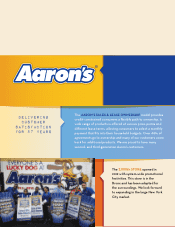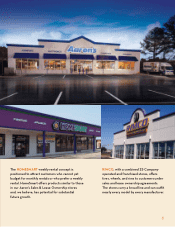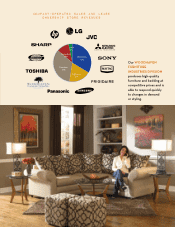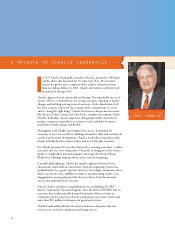Aarons 2012 Annual Report Download - page 16
Download and view the complete annual report
Please find page 16 of the 2012 Aarons annual report below. You can navigate through the pages in the report by either clicking on the pages listed below, or by using the keyword search tool below to find specific information within the annual report.
6
Manufacturing (Woodhaven Furniture Industries). Aaron’s is the only major furniture lease company in the
United States that manufactures its own furniture. We operate five furniture manufacturing plants and eight bedding
manufacturing facilities. By manufacturing our own specially designed residential furniture and bedding, we believe we
enjoy an advantage over our competitors. Manufacturing enables us to control the quality, cost, delivery, styling,
durability and quantity of our furniture products. Substantially all of Woodhaven Furniture Industries’ production is
leased and sold through our Company-operated and franchised stores.
Aaron’s Office Furniture Closure. After disappointing results in a difficult economic environment, in June 2010 we
announced plans to close all 12 of the then remaining Aaron’s Office Furniture stores and focus on the Company’s
sales and lease ownership business. As of December 31, 2011, we closed 11 of the Aaron’s Office Furniture stores and
had one remaining store open to liquidate merchandise; this final store was sold in August 2012. During 2010, we
recorded $9.0 million in charges related to write-down and cost to dispose of office furniture, estimated future lease
liabilities for closed stores, write-off of leaseholds, severance pay, and other costs associated with closing the stores and
the division. We did not incur significant charges in 2011 or 2012 related to winding down the division.
Industry Overview
The Rent-to-Own Industry
The rent-to-own industry offers customers an alternative to traditional methods of obtaining electronics, computers,
home furnishings and appliances. In a typical industry rent-to-own transaction, the customer has the option to acquire
merchandise over a fixed term, usually 12 to 24 months, normally by making weekly lease payments. The customer
may cancel the agreement at any time by returning the merchandise to the store, generally with no further lease
obligation. If customers lease the item to the full term, they obtain ownership of the item, though they can choose to buy
it at any time.
The rent-to-own concept is particularly popular with consumers who cannot pay the full purchase price for merchandise
at once or who lack the credit to qualify under conventional financing programs. Rent-to-own is also popular with
consumers who, despite good credit, do not wish to incur additional debt, have only a temporary need for the
merchandise or want to try out a particular brand or model before buying it.
We believe that the decline in the number of furniture stores, the limited number of retailers that focus on credit
installment sales to lower and middle income consumers and the current tightening consumer credit have created a
market opportunity for the industry. The traditional retail consumer durable goods market is much larger than the lease
market, leaving substantial potential for industry growth. We believe that the segment of the population targeted by the
industry comprises approximately 50% of all households in the United States and that the needs of these consumers are
generally underserved.
Aaron’s Sales and Lease Ownership versus Traditional Rent-to-Own
We believe that our sales and lease ownership model is unique. By providing customers with the option either to lease
merchandise with the opportunity to obtain ownership or to purchase merchandise outright, we blend elements of rent-
to-own and traditional retailing. We believe our sales and lease ownership program is a more effective method of
retailing our merchandise to lower to middle income consumers than a typical rent-to-own business or the more
traditional method of credit installment sales.
Our sales and lease ownership model is distinctive from a typical rent-to-own business in that we encourage our
customers to obtain ownership of their lease merchandise. Based upon industry data, we believe when merchandise is
initially leased our customers obtain ownership more (over 46%) versus rent-to-own businesses in general
(approximately 25%). We believe our sales and lease ownership model offers the following unique characteristics
versus traditional rent-to-own stores:
Lower total cost—our agreement terms typically provide a lower cost of ownership to the customer.
Wider merchandise selection—we generally offer a larger selection of higher-quality merchandise.
Larger store layout—our stores are typically 9,000 square feet, nearly twice the size of typical rent-to-own
stores.
























